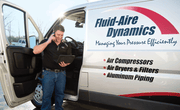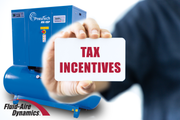Air compressor location not only affects compressor maintenance and performance… it can impact your facility's efficiency and your employees' productivity, too! But do you know how to determine where your air compressor should go? Our air compressor installation guide will help you find the perfect location for your compressor. Here are 6 key factors that impact where you place your air compressor.
Contact Fluid-Aire Dynamics for expert air compressor installation and system setup.
6 Key Factors for Compressor Placement
Proper air compressor installation is an important aspect of compressed air system design. That starts with air compressor location. There are several key factors that impact the placement of the compressor. During air compressor setup, it is important to consider the operating environment for the unit, the distance between the compressor and air-using processes, ease of access for maintenance and inspection, and the comfort and safety of employees. It is also essential to follow all safety guidelines in the air compressor installation guide, including electrical safety standards.
See the air compressor diagram below to see how the compressor fits in with other elements of the total compressed air system.

1. Serviceability and Accessibility
Your air compressor should always be accessible for servicing. A rule of thumb is to place your compressor somewhere that allows a minimum of a three-foot radius around the unit. This allows doors on any side of your compressor to open fully, meaning different components can be changed during servicing.
Keep in mind, some components in your machine are larger and may need more space in order for them to be easily removed, replaced or repaired. Make sure you incorporate the total compressor clearance requirements into the placement of your air compressor.

That being said, there will be situations that require you to place your air compressor in a less-than-ideal spot, which may mean you need to take additional steps to ensure your compressor is safe and accessible. For example, if you operate your unit on a mezzanine, you will need permanent stairs and support bars, so servicing the compressor is safer and more convenient. You will also need to ensure that the mezzanine can adequately support the weight of the equipment, including the compressed air storage tank if it is hypothetically filled with water (in the case that the condensate drain fails).
If your air compressor is in a more complex location, keep in mind that repairs, major component replacements, and even regular preventative maintenance are going to be more expensive due to the increase in time, and possibly the number of technicians, required to perform these tasks.
2. Temperature and Ventilation
Air circulation and ambient room temperature are critical to keeping your system running with minimal downtime.
When installing your air compressor, make sure the initial air temperature in the room is cool. Air compressors generate their own heat, which means additional heat can cause your machine to shut down. The optimal temperature for the compressor room should be 50–85℉. If your air compressor runs in a room outside this temperature range, it will be working hard to keep up, causing the lubricants to break down more quickly. This will require more frequent maintenance of your compressor.
Your system will also need proper air circulation and ventilation to prevent high-temperature shutdowns. Compressors exhaust warm air. If your system is in an enclosed space, this can cause the room to get warmer and warmer, which will lead to your compressor shutting down at high temperatures. You can prevent this by ducting your exhaust air to the outdoors. This allows your unit's intake air to be much cooler while reducing the likelihood of air compressor overheating.

Aire Tip: You can have two ducts from the exhaust air, one leading outside for the summertime, and one leading into your facility for the wintertime. This saves you money on your heating bill, or if you don't have heating, it heats your facility for free!
3. Proximity to Power Supply
Is there a power source near your compressor? Believe it or not, the distance between your power supply and your system matters. The further away your power distribution center is, the more expensive it is to wire your compressor.
According to the national electric code guidelines, for every 100 feet between your equipment and the power distribution source, you have to increase your wire by one size. This causes the cost of powering your compressor to increase as the distance to the power source increases, so be sure to check the location of power distribution before settling on a location for your air compressor.
Proper grounding and bonding for an industrial air compressor are essential for ensuring electrical safety and protecting both equipment and personnel. It helps prevent static electricity buildup and electrical faults, reducing the risk of fire or equipment damage due to electrical surges or short circuits.
4. Ambient Air Cleanliness

If the ambient air coming into the compressor air intake is dirty, this could require more maintenance and lead to higher levels of contamination in the air supply. If possible, place your air compressor somewhere that has access to clean air. If you cannot avoid putting your compressor in an area with significant dust and dirt in the air, you could consider ducting in your intake air. You should also use an intake filter to ensure clean air is coming into your system.
5. Proximity to Point-of-Use
Placing the compressor as close as possible to the equipment or processes it serves is key to minimizing pressure drops and energy losses. The farther compressed air has to travel through piping, the more energy is required to maintain proper pressure levels, which can lead to inefficiency and higher operating costs. Additionally, long piping runs increase the risk of leaks and pressure fluctuations, which can impact performance. By positioning the compressor near its point of use, you ensure a more reliable and energy-efficient air delivery system.
Proper distribution system design is also important in air compressor installation. A well-designed modern loop distribution system ensures optimal airflow, reduces wear and tear on equipment, and improves overall performance by delivering air exactly where it's needed, when it's needed.

6. Noise and Vibration Levels
Are your employees near your air compressor? If so, you may want to reevaluate where your compressor is located. Some units can be noisy, which can lead to decreased productivity and unhappy employees.

If your unit is exceptionally loud, you can consider taking one of the following actions:
- Move your compressor away from your employees.
- Get a quiet rotary screw air compressor.
- Build a compressor room for your air compressors with sound-absorbing walls.
A commercial air compressor can also cause vibrations through floors. This can also lead to employee disruption for those working nearby. If your compressor is causing vibrations, you can use vibration dampeners to limit the transfer between the air compressor and the floor it is mounted to.
Get Expert Help with Air Compressor Installation and System Design

Optimizing the placement of your air compressor is one of the key factors in efficient, reliable operation. Proper placement minimizes energy losses, prevents overheating, and reduces wear and tear on the equipment, all of which contribute to longer system life and lower operating costs. By considering factors like ventilation, accessibility, and proximity to the point of use, you can ensure your compressor operates at peak performance. For expert guidance on air compressor installation and compressed air system design, contact Fluid-Aire Dynamics. Our team can help you maximize the efficiency and reliability of your compressor installation.
FAQs
Where should I place my air compressor?
Your air compressor should be placed in a clean, dry, and well-ventilated area to ensure optimal performance and longevity. It's important to select a location with easy access for routine maintenance and repairs. Additionally, consider noise levels and proximity to the point of use to minimize energy loss from long piping runs. The ideal location is a separate compressor room that is clean and well-ventilated or air-conditioned to prevent excessive heat buildup.
Can I install an air compressor outdoors?
Yes, you can install an air compressor outdoors, but precautions must be taken to protect it from weather conditions. Ideally, the compressor should be housed in a weatherproof enclosure to prevent exposure to rain, snow and extreme temperatures. Proper ventilation is also necessary to avoid overheating. If the compressor is not housed and ambient temperatures drop below freezing, steps should be taken to weatherize the compressor for winter conditions.
How much clearance does an air compressor need?
An air compressor typically needs at least three feet of clearance on all sides to allow for proper airflow and easy access. This space ensures that the compressor can stay cool during operation and that technicians have enough room to perform inspections, repairs and routine servicing without obstruction.
What happens if an air compressor gets too hot?
If an air compressor gets too hot, it can lead to overheating, causing system shutdowns, reduced efficiency, or even permanent damage to internal components. Overheating can also shorten the lifespan of the compressor, increase the risk of fire, and lead to higher maintenance and repair costs. Proper ventilation and temperature control are essential to avoid these issues.
How does compressor placement affect performance?
The placement of your air compressor directly affects its efficiency and functioning. Compressors located far from the point of use may experience pressure drops, leading to increased energy consumption as the system works harder to maintain adequate pressure. Additionally, poor placement in a hot, humid, or dirty environment can lead to premature wear, overheating, and reduced lifespan. Proper placement optimizes airflow, minimizes energy loss, and ensures reliable performance.





